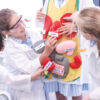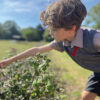by Lorraine Allman
While every child is different, many of the everyday situations families find themselves in provide plenty of opportunities for nurturing children’s confidence and can-do approach to life. Author and educator Lorraine Allman shares her insight and practical tips for boosting children’s confidence that don’t cost a penny, and not a craft basket in sight.
Patience is a virtue
When children achieve something on their own it helps them develop a sense of what they are capable of, fuelling excitement and of course self-confidence. Just watch a child’s face when they manage to tie their shoe laces for the first time or when you let go of the saddle and they realise they are riding the bike by themselves.
Mastering many of the basic skills independently such as tying shoelaces, brushing teeth or making their bed, is a big achievement for any child, and taking steps towards their independence should be celebrated, but bear in mind it can require a lot of patience from both you and them. The more opportunities you give them to practise, with gentle guidance and a good helping of patience, the more they will learn the importance of persistence and determination in achieving success.
Let them take the lead
Giving children the opportunity to take the lead can really boost their confidence and self-belief. This could be simple things such as taking ingredients out of the fridge ready for baking, or try these two fun activities:
• If I were in charge… next time they’re dressing up as a king, queen, or superhero, ask them “What laws would you pass if you were in charge?” Encourage them to go beyond the expected ‘children can eat as many sweets as they wanted’ to explore their innate sense of what is fair
and desirable.
• Do it my way! – they give you instructions to carry out an activity of their choice. Ideally, this will be something they’ve seen you complete lots of times before such as making a hot drink or a sandwich. You must follow their instructions exactly as they are given! Afterwards talk about how they found it and if the end was result was what they were expecting.
Acceptance and support
Self-esteem, particularly in early years, is in the main based on children’s perceptions of how their parents view them, which will show itself through both words and actions. A positive level of engagement – support, trust, and encouragement –
where children feel loved, accepted, and supported, has been shown to nurture children to become more confident, emotionally resilient, and secure.
Showing empathy with how a child is feeling by commenting on and normalising their experiences is important. For example, perhaps they’re upset because a toy has broken. First let them know you recognise they are upset “I can see you’re upset”, then move on to helping them see there are choices about what to do next. For example, seeing if the toy can be mended, or tapping into their curiosity and opening up the toy to discover how it worked. Try not to rush in to fixing things, let them feel empowered to make the decision and know that it’s okay to be upset.
Team family
Whatever the structure of your family, large or small, home is the perfect setting for children to learn and understand what it means to be part of a team in a supportive environment. Achieving things together reinforces teamwork and the value of working together towards a common goal. Family is the first team children experience, and what they learn in the home team will shape their attitudes and character for years to come. Encouraging children to express themselves, to listen, and to exchange ideas all helps in building their confidence. Try this activity:
• ‘Top Dog’ – one child is appointed ‘the boss’. They take the lead in assigning household tasks to family members (including themselves!) and making sure all the jobs get done. They will need to negotiate and make sure tasks allocated are age-appropriate and achievable. When the tasks have been completed, discuss who gets to be ‘Top Dog’ next time and what lessons have been learned.
Be a (not quite perfect) role-model
We know children learn more from what we do than what we say, and this is never truer than learning social skills such as being confident with others. Model the way in which you would like them to be with others, for example how you introduce yourself to new people, how you ask for help, thank people for their time, and give compliments.
Modelling positive traits such as curiosity and perseverance, listening to ideas of others, and taking a methodical approach to problems can also have a powerfully beneficial effect on children’s confidence. Don’t feel you have to be perfect though – in fact, it’s better to demonstrate openness about mistakes along with a sense of curiosity and determination to resolve problems, even encouraging them to help in exploring possible solutions where appropriate.
Decisions, decisions
The more children are involved in decision making, the more their confidence and self-belief will grow. Start with small decisions so it’s not too over-whelming for younger children, for example, offering a choice of two t-shirts to wear, or two sandwich fillings to choose from. For older children, get them involved in deciding where to go on a family trip, what route to take or what to pack.
Stand back and sweat the small stuff
Giving children the opportunity to work out solutions for themselves rather than having a parent rush in to fix things not only builds confidence and self-belief but also helps develop their imaginative and independent thinking skills. Children learn problem solving skills best through experiences which are meaningful to them so creating space in the everyday for them to explore and experiment with solutions to problems rather than intervening, is to be encouraged. From simple situations such as why a plastic lid won’t close, to how to overcome the problem of mis-matched socks, this is one of the few times when ‘sweating the small stuff’ really matters – talk about the problem, stand back, and listen to your child’s take on the solutions!
Helping others
Encouraging children to use their natural skills and talents to benefit others not only nurtures enterprising characteristics and confidence, but helps them recognise their wider role in society and learn that they can make a difference in the world.
Examples may include:
• Holding a sponsored run, a bake sale or art sale to raise money for a charity if they enjoy running, cooking, or art.
• Helping a neighbour clear their path, or walk the dog if they like the outdoors.
• Volunteering at an animal shelter if they have a particular interest in caring for animals.
Don’t fear the ‘F’ word
It’s important to support children in becoming comfortable with things not working quite as expected. If they can learn to cope with the frustrations this may cause, even to relish the challenge and understand the need to be flexible, their confidence will really begin to shine through as they try new things without fear of failure.
Modelling this to children through our own behaviour is important. Take a simple example such as burning the toast – involving them in a light-hearted discussion about what happened and why shows that mistakes are not disasters, providing opportunities to learn more about cause and effect, and discovering better ways to do things.
Set realistic goals
Encouraging children to dream by having a picture of a mountain they want to climb, or of a person they would one day like to emulate can give you interesting insights into what they want, what excites them, or even what they fear. Encouraging an ambitious rather than defeatist approach to life will help develop children’s can-do character as can a simple to-do list.
Encourage them to write out, for example, ‘four things I want to do in the next eight weeks’. Talk through the list with them so they understand what needs to happen for each of those things to be completed, making sure timescales are realistic. As each new goal is achieved, take time to celebrate not just reaching it but also their determination to succeed, and watch their confidence grow.
Discover the joy of learning
The greatest gift to give a child in nurturing their confidence and can-do character is to help them discover the joy of learning through play from an early age. There are so many ‘teachable moments’ in the everyday provided children are given the time and space to explore, experiment, set goals, learn how to work with others, make mistakes and ‘bounce back’.
Lorraine is author of The Can-Do Child: Enriching the Everyday the Easy Way -packed with easy everyday activities and ideas to help nurture confidence and can-do characteristics and skills in children, making family time enjoyable and fulfilling for all.












